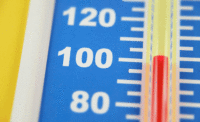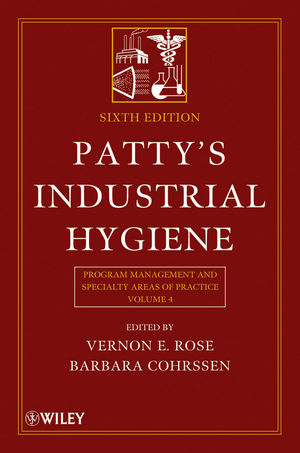Whenever heat stress exceeds occupational exposure limits, workers should be protected by acclimatization programs, training about symptom recognition and first aid, and provision of rest breaks, shade, and water. A Heat Index of 85°F (29.4°C) could be used as a screening threshold to prevent heat-related illness.
Heat stress, an environmental and occupational hazard, is associated with a spectrum of heat-related illnesses, including heat stroke, which can lead to death. NIOSH publishes recommended occupational exposure limits for heat stress (1). These limits, which are consistent with those of the American Conference of Governmental Industrial Hygienists (ACGIH) (2), specify the maximum combination of environmental heat (measured as wet bulb globe temperature [WBGT]) and metabolic heat (i.e., workload) to which workers should be exposed.
Exposure limits are lower for workers who are unacclimatized to heat, who wear work clothing that inhibits heat dissipation, and who have predisposing personal risk factors (1,2).
These limits have been validated in experimental settings but not at outdoor worksites.
To determine whether the NIOSH and ACGIH exposure limits are protective of workers, CDC retrospectively reviewed 25 outdoor occupational heat-related illnesses (14 fatal and 11 nonfatal) investigated OSHA from 2011 to 2016. For each incident, OSHA assessed personal risk factors and estimated WBGT, workload, and acclimatization status. Heat stress exceeded exposure limits in all 14 fatalities and in eight of 11 nonfatal illnesses. An analysis of Heat Index data for the same 25 cases suggests that when WBGT is unavailable, a Heat Index screening threshold of 85°F (29.4°C) could identify potentially hazardous levels of workplace environmental heat.
Protective measures should be implemented whenever the exposure limits are exceeded.
The comprehensive heat-related illness prevention program should include an acclimatization schedule for newly hired workers and unacclimatized long-term workers (e.g., during early-season heat waves), training for workers and supervisors about symptom recognition and first aid (e.g., aggressive cooling of presumed heat stroke victims before medical professionals arrive), engineering and administrative controls to reduce heat stress, medical surveillance, and provision of fluids and shady areas for rest breaks.
The sample consisted of 25 heat-related illnesses that occurred during outdoor work, 14 (56.0%) of which were fatal. Approximately half (12 of 25) of workers had at least one predisposing personal risk factor. Workload was moderate, heavy, or very heavy in 13 of 14 fatalities; the remaining fatality involved light workload in an unacclimatized worker. Estimated WBGT and Heat Index did not differ significantly across categories of workload or acclimatization status. The range of WBGT was 79°F–94°F (26.1°C–34.4°C). The sensitivity of the NIOSH exposure limits was 100% (14 of 14) for detection of fatal heat stress and 72.7% (eight of 11) for detection of conditions that caused nonfatal illness.
The median Heat Index was 91°F (33.3°C) and ranged from 83°F to 110°F (28.3°C to 43.3°C). The Heat Index was <91°F (32.8°C) in 12 of 25 cases, including six of 14 fatalities. Among workers wearing a single layer of normal clothing (21), the minimum Heat Index was 85°F (29.4°C), and four of nine nonfatal illnesses and four of 12 fatalities occurred when the Heat Index was between 85°F (29.4°C) and 90°F (32.2°C).
Because WBGT incorporates four environmental factors (air temperature, relative humidity, wind speed, and radiation [often sunlight]) that contribute to heat stress, it is the recommended workplace environmental heat metric. In 2016, NIOSH reiterated this recommendation in an updated publication that defines WBGT-based occupational exposure limits. The limits were derived from human experiments and have high sensitivity for detecting unsustainable heat stress in laboratory settings.
Heat Index is an “apparent” temperature that combines humidity and air temperature to quantify what the conditions “feel like” to the human body. Heat Index was designed for the general public, based on algorithms that assume a person is wearing light clothing and walking in a shaded area with a light breeze. Heat Index does not account for the effects of direct sunlight, stagnant air, work clothing, and strenuous activities.
Employers often obtain Heat Index information from publicly broadcasted weather reports or forecasts that do not necessarily reflect conditions at their worksites. These limitations preclude Heat Index from supplanting WBGT as the occupational gold standard. Nonetheless, at outdoor worksites where WBGT is unavailable, Heat Index is sometimes used to estimate environmental heat. This study demonstrates that workers wearing normal clothing are at risk for heat-related illness when Heat Index is ≥85°F (29.4°C). Whenever the Heat Index is ≥85°F, employers should exercise extra vigilance and implement additional precautions, which could include a more accurate WBGT-based environmental heat assessment.
Current occupational Heat Index guidance might not be sufficiently protective. For example, although OSHA does not have an enforceable permissible exposure limit for heat stress, OSHA guidance states that a Heat Index of <91°F (32.8°C) is associated with “lower” risk of heat-related illness unless other factors (e.g., direct sun, little air movement, strenuous workload, or nonbreathable clothing) are present. However, six of 14 deaths in this report occurred when the Heat Index was <91°F.
Additional evidence supports the possibility of serious illness when the Heat Index is <91°F. Fourteen percent of moderate to severe heat-related illnesses at a U.S. military training installation and at least 25% of heat-related illnesses in Washington agriculture and forestry workers occurred when the Heat Index was <90°F (32.2°C). Some employer reports of heat-related hospitalizations to OSHA’s Severe Injury Reports database have been associated with a Heat Index of <80°F (26.7°C). A recent mathematical analysis demonstrated that the NIOSH exposure limits can be exceeded when the Heat Index exceeds 85°F (29.4°C) (10).
Source: CDC








